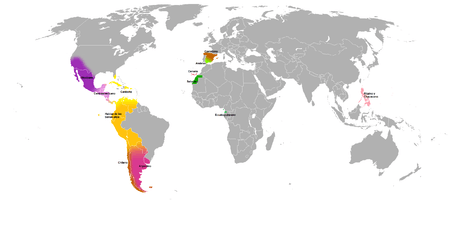Philippine Spanish
| Philippine Spanish | |
|---|---|
|
Español filipino Castellano filipino | |
| Native to | Philippines |
| Region | Cavite, Cebu, Manila, & Zamboanga |
| Ethnicity |
Spanish Filipino Spanish people of Filipino ancestry Zamboangueño people |
Native speakers |
(439,000 (2007) with "native knowledge"[1] cited 1990 census)[2] 2,700 |
|
Indo-European
| |
| Latin (Spanish alphabet) | |
| Official status | |
Recognised minority language in |
|
| Regulated by | Academia Filipina de la Lengua Española |
| Language codes | |
| ISO 639-3 | – |
| Glottolog | None |
Philippine Spanish (Spanish: español filipino, castellano filipino) is a variant of standard Spanish spoken in the Philippines mostly by Spanish Filipinos. Since the capture and occupation of the Philippines by the United States following the Spanish-American War, the dialect has lost most of its speakers and it might be now close to disappearing.
History

Philippine Spanish is a dialect of the Spanish language in the Philippines. The variant is very similar to Mexican Spanish, because of Mexican and Latin American emigration to the Spanish East Indies over the years.
From 1565 to 1821, the Philippines which were a part of the Spanish East Indies, were governed by the Captaincy General of the Philippines as a territory of the Viceroyalty of New Spain centered in Mexico. It was only administered directly from Spain in 1821 after Mexico gained its independence that same year. Since the Philippines was a former territory of the Viceroyalty of New Spain for most of the Spanish colonial period, Spanish as was spoken in the Philippines had a greater affinity to American Spanish rather than to Peninsular Spanish.
Chavacano
| Spanish language |
|---|
 |
| Overview |
| History |
| Grammar |
| Dialects |
| Dialectology |
| Interlanguages |
| Teaching |
An estimated 689,000 people speak Chavacano, a Spanish-based creole.[3][4] In 2010 the Instituto Cervantes de Manila put the number of Spanish speakers in the Philippines in the area of three million, which included the native and the non-native Chavacano and Spanish speakers as well since there are some Filipinos who can speak Spanish and Chavacano as a second, third, or fourth language.[5]
Phonology
Philippine Spanish has the following characteristics. Some of these have been passed on the manner of everyday speech of Filipinos; such as /x/ being [h] and seseo.
y/ll distinction
As in some dialects in northern Spain and in some bilingual zones (Bolivia, Paraguay, and Peru) in Latin America, there is a phonological distinction between the sounds represented by 'll' /ʎ/ and 'y' /ʝ/. For example, "silla" /ˈsiʎa/ is not pronounced /ˈsiʝa/ (Tagalog "silya"). However, yeísmo, which merged the two, occurs in some words like "cebollas" /seˈboʝas/ (Tagalog "sibuyas") and "caballo" /kaˈbaʝo/ (Tagalog "kabayo").
Seseo
As in Latin American Spanish, /θ/ is not distinguished from /s/. For example, cerveza /seɾˈbesa/ (Tagalog "serbesa").
Retraction of /x/ to [h]
The velar jota sound /x/ is retracted to glottal [h], which also occurs in Andalusian, Caribbean, Canarian, and Colombian Spanish: "Jorge" [ˈhoɾhe ~ ˈholhe].
Merger of /d/ and /ɾ/, /p/, and /f/ and non-open vowels
Malayo-Polynesian countries often interchange /d/ and /ɾ/, /p/ and /f/, /e/ and /i/ as well as /o/ and /u/), which also occurs in Philippine Spanish. For example, "pared" [paˈdeɾ] (Tagalog "pader"), Filipinas [piliˈpinas] (Tagalog "Pilipinas"), entender [intinˈdiɾ] (Tagalog "intindi") and ojal [uˈhal] (Tagalog "uhal").
No aspiration of /s/
Unlike many Spanish and Latin American dialects, syllable-final "s" is always pronounced as an alveolar sibilant [s], rather than a glottal fricative [h]. For example, "amores secos" [aˈmoɾes ˈsekos].
Retention of [h] of words originating from Latin f
Words like "hacer" [aˈseɾ], "hablar" [aˈblaɾ] come from the Latin words "facere" and "fabulare," respectively. However, in Philippine Spanish, the initial letter is pronounced as [h]; in other dialects, it is either silent or [x]: [haˈseɾ] and [haˈblaɾ] (Tagalog "habla"). Because /x/ in Philippine Spanish is glottal [h], it is best to consider such words to be phonemically /xaˈseɾ/ and /xaˈblaɾ/, rather than to postulate a marginal phoneme /h/. The same can occur in Andalusian and Caribbean Spanish.
[ɾ–l] shift at the end of syllables
At the end of a syllable of a word or a word itself, if the syllable/word ends with an l or r, /l/ becomes [ɾ] and /ɾ/ becomes [l] often. For instance, almíbar [aɾˈnibal] (Tagalog "arnibal), rezar [daˈsal] (Tagalog "dasal"). This also occurs in Andalusian and Caribbean Spanish.
Orthography
Diacritic marks are almost always left out except for the tilde on the ñ because of the use of American machines and the in capability of using such marks by English-language media companies. Typewriters sometimes include the ñ, but they do not include accented vowels. Computer keyboards have always used the US standard layout, which includes neither ñ nor combining diacritics. Spanish words, however, are vocally stressed the same way as by other Spanish-speakers.
Vocabulary
From Latin American Spanish
The following American Spanish words are also used in Philippine Spanish because of the Manila–Acapulco Galleon trade.
Words Present in the RAE Dictionary:
- camote, camotal "a sweet potato"
- champurrado "Mexican chocolate porridge"
- chile "pepper"
- chongo "monkey" (from chango)
- jícama "Mexican turnip"
- mecate "whip"
- zacate, zacatal "grass"
Other Words:
From Peninsular Spanish
Peninsular Spanish started to influence the vocabulary of Philippine languages after the Philippines was administered directly from Spain. For instance, Philippine Spanish uses "patata" (potato) instead of "papa", "gamba" (shrimp) instead of "camarón", "vosotros" (you, informal plural) instead of "ustedes", "melocotón" (peach) instead of "durazno", etc.
Unique words
- asuán "Aswang" Evil entity of the traditional Filipino folklore
- barcada "group of friends"
- bata "child"
- baguio "Typhoon"
- bolo Campaign knife
- cuidado To become responsible for someone or something (Similar to "Tomar cuidado", present in other Spanish speaking geographies)
- feluz "Velvet"
- juramentado "demented"
- lanceta "dagger"
- lampasear "to clean the floor through a coconut husk"
- mamón "fluffy cake"
- puto "round-shaped rice cake"
- rocabay Kalash.
- tapa "dried or cured beef, mutton, venison or horse meat" / (also present in the Argentine slang "lunfardo": a common food related to the Argentina "asado" a type of roasted beef)
References
- ↑ realinstitutoelcano.org, 2007
- ↑ Spanish at Ethnologue (18th ed., 2015)
- ↑ Spanish creole: Quilis, Antonio (1996), La lengua española en Filipinas (PDF), Cervantes virtual, p. 54 and 55
- ↑ Número de hispanohablantes en países y territorios donde el español no es lengua oficial Archived 29 April 2012 at the Wayback Machine., Instituto Cervantes.
- ↑ "El retorno triunfal del español a las Filipinas". Retrieved 2010-07-11.
External links
- The Teaching of Spanish in the Philippines, UNESCO, February 1968
- List of Tagalog words of Spanish origin, self-published, tripod.com
- Semanario de Filipinas, Philippine Weekly news blog
- E-Dyario Filipinas, online newspaper
- Alas Filipinas, the first and only Spanish blog in the Philippines
- Revista Filipina, online magazine
- Cohen, Margot. Filipinos Learning Not to Scorn Spanish. Yale Center for the Study of Globalization, Yale University. April 2010.
- Asociacion Cultural Galeon de Manila, Spanish-Philippine cultural research group based in Madrid (in Spanish and English).
- Círculo Hispano-Filipino (in Spanish and English)
- Website of Kaibigan Kastila
- Spanish Made Easy and Practical For Filipinos
- Spanish Program for Cultural Cooperation
- Casino Español de Manila
- Casino Español de Cebú
- Instituto Cervantes de Manila
- Documentary "El Idioma Español en Filipinas" (Spanish)